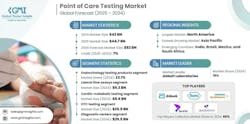The global point of care testing (POCT) market was valued at USD 42 billion in 2024 and is projected to expand from USD 44.7 billion in 2025 to USD 82 billion by 2034, reflecting a compound annual growth rate (CAGR) of 7%, according to the latest report by Global Market Insights Inc.
This steady growth highlights the increasing importance of decentralized diagnostic solutions in modern healthcare systems. Point of care testing allows rapid, accurate, and on-site diagnosis, enabling timely clinical decisions and improving patient outcomes—especially in resource-limited and emergency settings.
A primary factor driving the POCT market is the upward trend in disease prevalence among developing countries, which continues to elevate the demand for accessible and rapid diagnostic tools. Chronic conditions such as diabetes, cardiovascular disorders, and infectious diseases are on the rise, emphasizing the need for convenient diagnostic options outside traditional laboratories.
Furthermore, the surging number of pathology labs and services equipped with advanced diagnostic equipment is enhancing clinical adoption. Improved infrastructure, coupled with digital integration, supports wider use of POCT devices in hospitals, clinics, and home-care settings. This growing accessibility is transforming how diagnostics are delivered across both developed and emerging markets.
Despite its strong momentum, the point of care testing market faces regulatory hurdles. A stringent regulatory framework often slows product approvals and market entry, limiting innovation and expansion opportunities for manufacturers. Compliance with evolving standards and validation requirements adds complexity to product development and commercialization timelines.
On the opportunity front, growing demand in remote and rural areas is creating new growth avenues for POCT providers. These portable and easy-to-use diagnostic solutions bridge the gap in underserved regions, enabling faster disease detection where access to centralized laboratories is limited. This expansion into low-resource settings represents a significant step toward equitable healthcare delivery worldwide.
Based on product type, the market is segmented into endocrinology testing products, cardiometabolic testing products, infectious disease testing products, coagulation testing products, tumor/cancer marker testing products, urinalysis testing products, hematology testing products, drug-of-abuse testing products, fecal occult testing products, and others.
The endocrinology testing products segment accounted for a substantial 33.1% market share in 2024, driven by rising cases of diabetes and thyroid disorders. Continuous innovation in glucose monitoring and hormone testing devices further supports this segment’s dominance.
North America dominated the global point of care testing industry, capturing a 33.4% share in 2024. The region’s leadership is attributed to robust healthcare infrastructure, technological advancements, and early adoption of portable diagnostic solutions. In addition, the presence of major industry players and favorable reimbursement frameworks continue to fuel market expansion across the United States and Canada.
The global point of care testing market is poised for sustained growth through 2034, supported by technological innovation, increased healthcare accessibility, and expanding diagnostic networks. As healthcare systems continue to prioritize early detection and rapid intervention, POCT solutions will play a vital role in delivering efficient, patient-centric diagnostics across diverse clinical settings.

